Machines whirring at migratory bird sanctuary
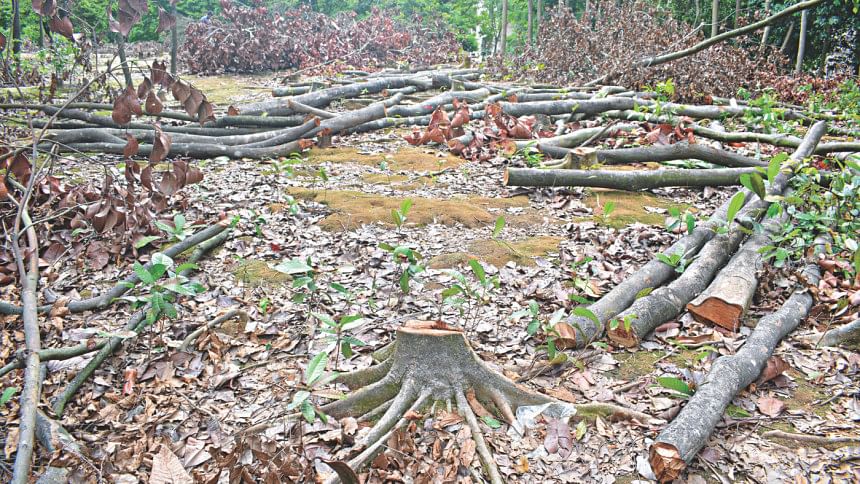
Around halfway through the Jahangirnagar University campus one would notice age-old rusting signboards with caution warnings like "Migratory birds come here. Don't honk, don't park beside the water-bodies, no fireworks." The knowledge is as old as time: this is the habitat for migratory birds who are going to be flying across continents for this one special spot—with some coming from as far as Siberia—and humans should be respectful of them, por favor.
Then there is Jahangirnagar University's (JU) master-plan, which will be building 23 new student dormitories, administrative buildings and lecture halls in the short-term, and proposes to build similar such buildings in the future. The project, costing Tk 1445.36 crores was approved by the Executive Committee of National Economic Council last October, with the vision of catapulting JU into a new era where there are adequate resources for everyone.
The locations of some of these planned new constructions are being proposed right beside the lakes where these migratory birds make their homes in the winter months, leading to questions about their impact on the ecology.
Take for example, the proposed area for the building called the "Abdul Kader Mollah Convention Centre". Located right on the banks of a lake that is literally demarcated on Google Maps as "Migratory Bird Lake 3", the building promises quite the lake view.
There is more. An area on one side of "Migratory Bird Lake 1", where Al-Beruni hall is located, is demarcated for long-term construction of faculty buildings. There are quite a few other odd places like that. A spot on the banks of a huge lake surrounding an area locally called "Switzerland" is marked out for future halls. Sporadic constructions of various types—including extensions, demolitions—dot the banks of "Migratory Lake 2" in the proposed map.
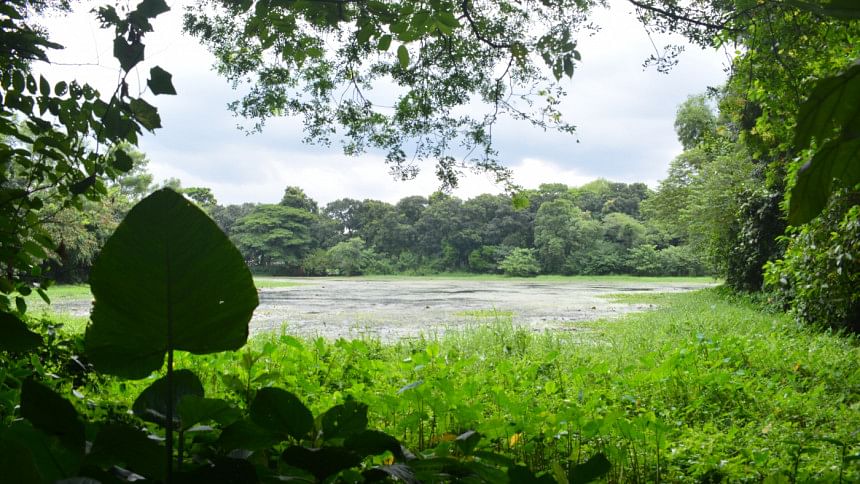
JU's predicament is difficult. The whole 697-acre campus is peppered with hauntingly beautiful lakes and lotus ponds, and the larger water-bodies are ecologically-critical areas. "One third of the campus are water-bodies, one third is greenery, so we only have a third for use. Of that only 21 percent is unused right now," says Mohammed Nasir Uddin, the director of the planning and development office at the university.
It is not possible to expand, without the structure falling beside one lake or another, he states. "The university has to fulfil its function. It cannot be a sanctuary for birds," says Nasir Uddin.
Professor Dr Md Khabir Uddin of the department of environmental sciences says that is possible to be both—but to do that, an Environmental Impact Assessment (EIA) is mandatory. "Expansion can happen, but we have to determine the impacts on the environment."
Unfortunately, there has been no EIA done for this master-plan that plans on doing construction around migratory bird lakes. "We have not done an Environmental Impact Assessment," says Nasir Uddin when asked. "Why would we need an EIA? We are not building a new university—we are only developing on an existing plan. The EIA was done in 1967 when the university was first being constructed."
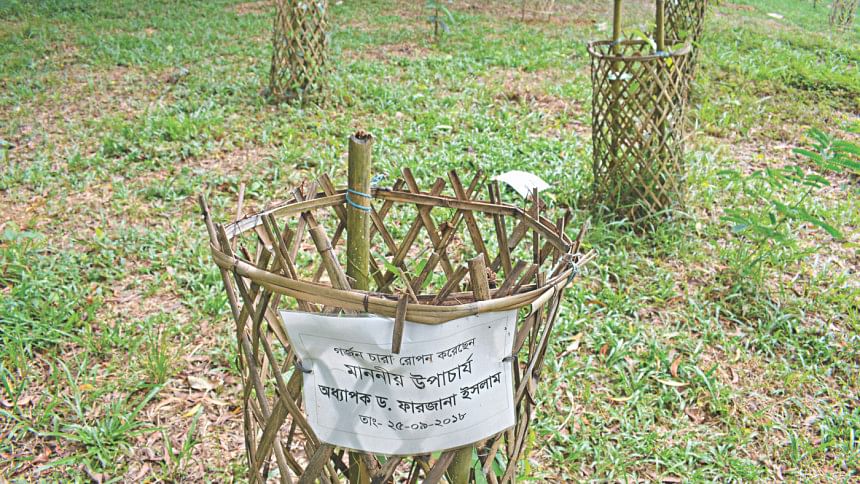
"However, we have done a feasibility study, in consultation with a team from Bangladesh University of Engineering Technology."
The feasibility study interviewed students, faculty and visitors, and also reviewed existing literature, to outlines the do's and don'ts of the plan. Their recommendations include ecologically-cognisant rules like "Bird's Fly zone connecting the main water bodies must be defined so that they can fly among the water bodies, to fetch food and shelter; No buildings should be built within this zone above 20 metres" and "Ecologically sensitive zones for fishing cats/mammals, amphibians and reptiles; must be preserved."
These are all well and good. But hear it from the author of the feasibility plan Dr Md Ashikur Rahman Joardar himself, a feasibility plan is not the same as an EIA.
"An EIA determines all the impacts a plan can have on an area. These could be both positive impacts or negative impacts. A feasibility study simply determines if a plan can be done or not. The university approached us for a feasibility study," explains Dr Joardar, who is an assistant professor at the department of architecture at BUET.
But as Dr AKM Rashidul Alam, professor at the department of environmental sciences at JU knows, a change to even the smallest microorganisms can impact the ecology of the migratory birds.
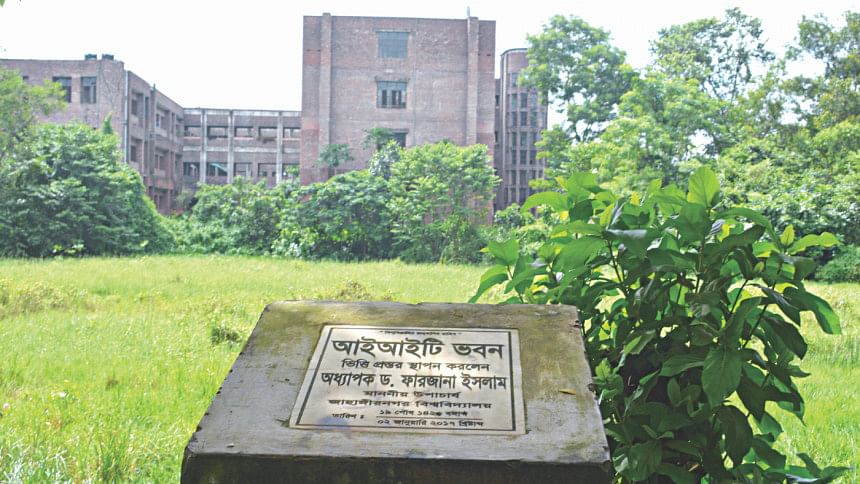
In one of his studies, he has found the answer to one crucial question: why do the birds visit some lakes and not the others? The answer lies in the presence of a tiny microorganism, called a phytoplankton.
The 2010 research titled "A Comparative Study of Phytoplankton Diversity in Relation to Water Quality of Migratory Birds Visiting and Non-visiting Wetlands of Savar" published in the Bangladesh Journal of Environmental Research found that the lakes frequented by the birds had a higher proportion of a certain species of the phytoplankton.
"Migratory birds non-visiting wetland was dominated by Chlorophyceae while migratory birds visiting wetlands were dominated by Bacillariophyceae," states the research paper. The paper also goes on to state that "The value of total nitrogen, total sulphur and total potassium was recorded higher in migratory birds non-visiting wetland than that of migratory birds visiting wetlands".
It also states that the presence of this phytoplankton is primarily dependent on the chemical qualities of water.
Dr Alam says, "The phytoplanktons are what we call primary producers. They are consumed by zooplankton who are consumed by animals like fish and insects, which are the food of migratory birds. A change in the water quality could change this."
Dr Alam was asked what would happen if waste water from construction sites, flowed over to the lakes where the birds reside. "If cement-mixed water flowed into the lakes, then the water's pH would go up and the water would become alkaline," he said. The pH of the water in the lakes visited by migratory birds is 6.26, he had found, which means the water is ever so slightly acidic.
His statement is supported by more recent research done at Jahangirnagar University as well. Published in the Journal of Biodiversity Conservation and Bioresource Management last December, the research found that the lakes visited by the birds are dominated by molluscs—which refers to the animal family of snails—and that these are very sensitive to the acidic quality of the water.
"It is noteworthy to mention that the macrobenthic diversity of this lake is much diversified and is significantly influenced by some water and soil parameters," the research concluded.
Star Weekend sourced the building contracts for several of the new constructions that are meant to happen in the short-term and upon examination, failed to find any directions being given to the contractors to test for environmental factors before, during and after construction.
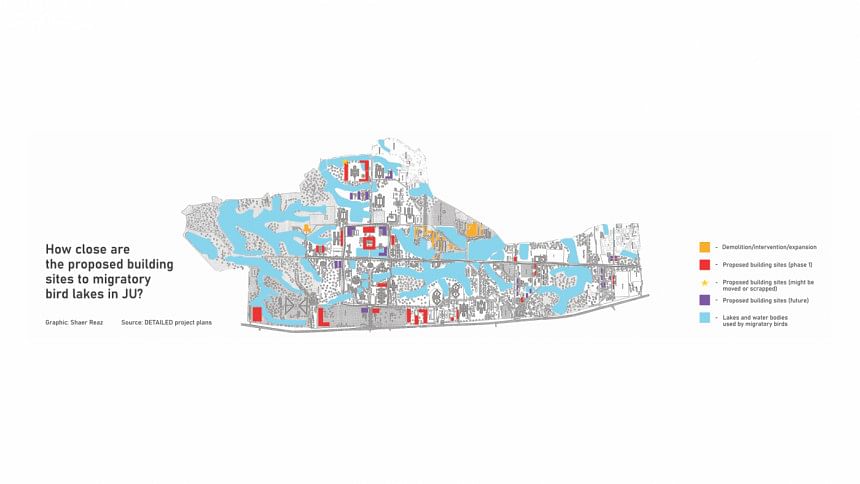
The contracts for example set out activity guidelines like "Do not wash vehicle, dispose [of] cement slurry, other hazardous substances etc. in water bodies" but does not ask the contractor to do routine testing of the adjacent water body or the soil. What will happen for example during monsoon, when it rains, and the rainwater from construction sites flow into the lakes, is a question that arises.
Another activity guideline is this, "The noise generating works will be scheduled only for during daytime and frequency of operation of construction equipment will be minimised." This automatically leads to the question—will there be heavy construction going on during migratory bird season?
"Construction has to happen during winter, during migratory bird season because that is the most ideal season. But we need to find out the effects and find ways to mitigate them. When they do construction abroad, they put up barriers to deal with sound, and nets to catch dust and waste discharge," says Prof Khabir Uddin.
Artificial space shortage leading to unplanned development?
The campus has been erupting in protests for weeks by now. The protesters at Jahangirnagar University are decrying what they call JU's history of unplanned development and calling for change. "The university has deviated from architect Mazharul Islam's masterplan long back. They need to progress in a planned fashion," says Professor Dr Anu Muhammad, from the department of economics.
Jahangirnagar University is a fully residential university, meaning they only take in as many students as the number of residential hall seats they have. One of the main reasonings behind the university's need for more halls, came from what the authorities call "seat shortage".
However, Dr Muhammad calls it an artificial seat shortage. "Politically powerful students occupy seats and the administration overlooks it because they need their (the students') backing to exist," he says. "Seat distribution in halls is completely in their control," he says.
Therefore, instead of aiming to build more residential halls, the university should focus on the root of the problem, he recommends.
Star Weekend zoomed in on one hall—Al-Beruni Hall—and did a calculation of how many students living there do not yet have beds assigned to them.
The hall has 128 rooms in total and all the rooms have two beds. There are 7 rooms, where each room is currently housing 7 students—that is, each room has 5 extra students stuffed inside them. In addition, there are 11 rooms where each room has 2 extra students. Then there is the student common-space, or "gonoroom" where 40 students with no beds live. This means there are 97 students living in Al-Beruni hall, whose assigned beds are currently occupied. The hall has three rooms specifically with one occupant each only, for politically powerful students.
Sunny Mahfuj, a young male student describes his experience of living under such conditions. "When I was put inside the common room, space was so constricted that I used to sleep outdoors. I slept inside the university buses, in front of the campus Shaheed Minar, or under the trees. I was constantly infected by bedbugs, but they were the tamest of allergies to crop up when living in the common space. There was this one bug that I was particularly allergic to, that made me swell up in hives, if it even so much as landed on me."
The next year he was put in a room with 14 students, that was actually meant for two. "A year of living like that, and I could not take it anymore, so I looked for housing off-campus," he says.
"This is an artificial shortage created by the politically powerful," says Dr Muhammad.
The campus's political problem came to a showdown last week, as a scandal involving the development plan hit the fan. Strong allegations appeared accusing the campus unit of Bangladesh Chhatra League of extorting the university's Vice-Chancellor in tandem with the central unit.
During the protests, a song composed by the students became viral. Some lines poignantly summarises the situation they face: "They force students to live in guest rooms, disturb them and subjugate them; They occupy the rooms and torment" and "The brothers will grab tenders, construct buildings, fill their pockets; They will demand 2 percent [of the loot] even if the axe falls on a single tree."
Going forward
The BUET consultants believe there is space for chance. "What we made is a guideline of where future construction can happen, keeping the environment in mind, but that does not mean the spots cannot be changed," says a leading BUET engineer who worked on the zoning of the land for JU's new development (he wished to be anonymous because BUET worked on the university's project as consultants).
All the teachers interviewed say that there is still time to execute the plan in a way that poses the least problem to the birds. "The whole university is a research laboratory, and our faculty have done years of research on the environment. The development plan can take into account the expertise of everyone," says Dr Alam.


 For all latest news, follow The Daily Star's Google News channel.
For all latest news, follow The Daily Star's Google News channel. 



Comments